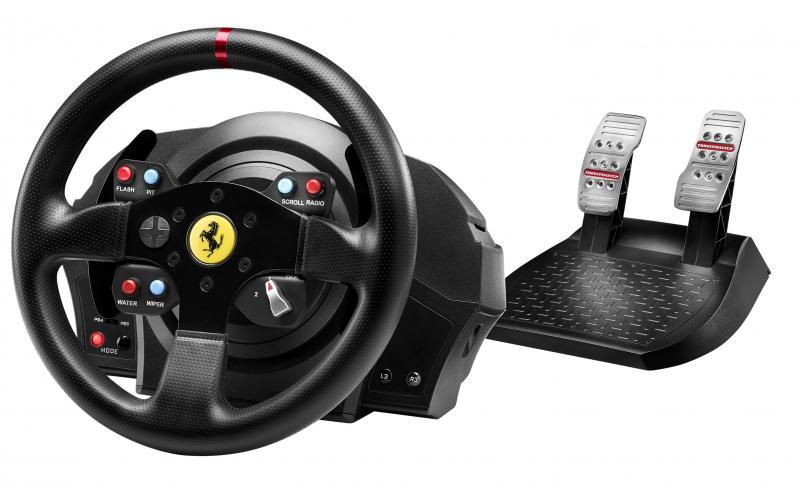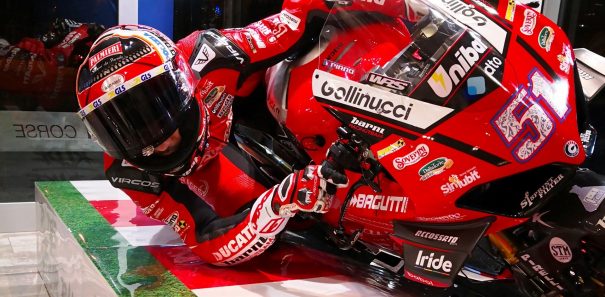Console owners are at a difficult crossroads when it comes to force feedback wheels. After being long-served by Logitech and Fanatec over the years, long-time owners of the G27 and CSR wheels were dismayed to find they no longer work for PS4 or Xbox One, despite being compatible for PC. In the case of the PS4, it’s since been revealed that Sony requires third party products to be fitted with a security chip in order to be compatible, but that’s of little comfort for disgruntled players wanting to get the optimum experience out of their racing game collection. It’s a shame, because my trusty Logitech G25 served me well over the years until it finally bit the dust from prolonged use.
Understandably, then, existing owners of these reliable racing wheels may find it hard to justify investing in another expensive peripheral, particularly when the range of compatible software is so limited at this point in the current-gen console’s infancy.
Your options are even more limited if you’re a PS4 player, too. Whereas Xbox One owners can also choose from the Mad Catz Pro in addition to the Thrustmaster 458 Italia TX (and not forgetting the revelation that Fanatec are also working on a new peripheral following their recent partnership with Microsoft), PS4 players currently only have two options courtesy of Thrustmaster (yes, I know, you can stop giggling now) to suit different budgets: the entry-level T80, or the high-end, flagship force feedback T300.

Wheel of Fortune
As the PS4’s first force feedback wheel, the T300 has a lot to live up to. Also compatible for PS3 and PC, this particular model is the GTE edition, which sports an alluring authentic 7:10 scale replica rim of the real life Ferrari 458 Challenge racing car. The T300RS, on the other hand, is specifically designed with PS4 users in mind, replacing the famous Ferrari badge with the standard PlayStation logo, along with a familiar button layout directly replicating a PS4 controller. Because of this, the T300RS is perhaps a more practical option if you plan to predominately use the T300 with a PS4. But let’s face it, having a prestigious Ferrari-branded wheel welcoming you into your living room is far more likely to turn heads and have on-lookers swooning like they just walked passed a real Ferrari.
The GTE’s face button controls are less intuitive by comparison, favouring authenticity over functionality. There’s a d-pad, but this is the only familiar button on the wheel resembling a conventional gamepad – the rest are designed to mimic the dashboard of the real life 458 Challenge car, so the controller button mapping isn’t initially obvious. As a result, traditional PlayStation button identifiers have been replaced with cosmetic dashboard functions such as ‘Flash,’ ‘Wiper’ and ‘Radio’. As you can see from the image below, it’s an impressively accurate replica:

Consequently, it took me a while to figure out how to get my PS4 to detect the wheel. Heaven forbid, I had to consult the instruction manual as a last resort (hint: to save you fumbling around, push down the flicker switch which acts as a PS ignition button). Despite some initial confusion, the buttons are all easily within reach of your thumbs when your hands are in a standard ‘ten and 2’ driving position, so you never have to take your hands off the wheel during play. They’re all well-made, with the exception of the d-pad which feels a tad loose and cheap.
The T300 also features built-in metal paddle shifters, which make a satisfyingly solid clicking sound when pressed. The T500 was often criticised for having static paddles that didn’t move with the wheel, so you have to commend Thrustmaster for adjusting the design accordingly for its successor.
Assembling the wheel is a swift and straight-forward process. The base isn’t quite as beefy as the T500, thus making it less cumbersome to fit on a wheel stand, and has been smartly designed with a quick release system to support interchangeable wheel rims. This means you can swap the wheel with a number of existing add-ons in the Thrustmaster ecosystem, including the Ferrari Formula rim and even the original T500 rim if you so desire. You simply lock the wheel rim into place and screw it in using the central clamp, which should take a couple of minutes at most.
There is a downside to the T300’s altered base design, however. A one-piece screw-mounting mechanism allows you to easily clamp the unit to a table, but if you plan to bolt it securely to a wheel stand it’s worth noting that you may need to drill some extra holes – the screw holes on my PlaySeat, which supports the T500, didn’t line up to the screws under the T300’s base. Being lazy, I opted to leave it clamped. While it did occasionally slip during heavy use, it still felt secure enough unbolted for the most part.
It’s disconcerting, too, to find that, in an age of wireless technology, the T300 doesn’t wirelessly connect to the console, despite having its own power supply. In addition to the power source, a USB connection to the console is required, while the pedals connect to the base via an Ethernet cable. The resulting unsightly trail of wires made my congested carpet look like Spaghetti Junction.
 In terms of dimensions, the T300 is comparable to its Xbox One cousin, the Ferrari 458 Italia TX, but is slightly smaller in diameter than the T500. At 11 inches, it’s a suitable size, with a robust and ergonomic design that feels naturally comfortable to hold for long sessions. Having said that, it’s so grippy that my thumbs were sometimes left with visible marks after clutching the wheel too tightly during some intense racing sessions.
In terms of dimensions, the T300 is comparable to its Xbox One cousin, the Ferrari 458 Italia TX, but is slightly smaller in diameter than the T500. At 11 inches, it’s a suitable size, with a robust and ergonomic design that feels naturally comfortable to hold for long sessions. Having said that, it’s so grippy that my thumbs were sometimes left with visible marks after clutching the wheel too tightly during some intense racing sessions.
Brilliantly, wheel rotation can also be manually adjusted from as much as 1080 degrees to 270 – a useful option if you want to reduce the rotation for driving sensitive single seaters, for example. Compared to the limitations of an analogue stick, the 1080 degree steering lock (that’s three full turns of the wheel) allows for a much finer degree of control, and is particularly ideal for drifters who constantly wrestle the wheel to keep the car under control during an extended powerslide.
The solid build quality of the wheel cannot be praised enough, but the cheap rubber texture covering the edges ultimately lets it down – it’s a far cry from the luxurious leather surrounding the Logitech G27 or the authentic alcantara found on the Fanatec CSR our hands have grown accustomed to over the years. The authentic materials on these wheels make you feel like you’re gripping the wheel of an actual car, whereas the T300 feels like a plastic toy to hold. The visible seam joining the material together through the centre doesn’t do it any favours, either. For the asking price, you’d expect the wheel to be lavished with a more premium material.
Initial impressions are also dampened when you compare its price point to some of its rivals. The T300 will set you back around £300, but it doesn’t include a clutch pedal or gear stick. If these are must-have accessories for you, then be prepared to fork out extra for some additional add-ons. By contrast, the cheaper Logitech G27 includes a gear stick and clutch pedal as standard, as well as the superior leather texture coating the wheel.
Force feedback to be reckoned with
Fortunately, none of that matters once you get behind the wheel and go for a drive in a supported game. Simply put, the T300 has, without question, the best force feedback I’ve had the pleasure to experience on console.
It’s thanks to a sophisticated, industrial strength brushless motor system delivering smooth, powerful and precise feedback that accurately simulates the sensations of driving and totally transforms your racing experience. There’s no noticeable ‘notching’ sensation either, unlike most wheels where you can feel the inner-mechanisms which detracts from the immersion. The result is by far the smoothest force feedback wheel available in the market, making you feel truly connected to the virtual road like never before.
Using a button to switch seamlessly from PS3 to PS4 compatibility, Gran Turismo 6 unsurprisingly provided the best overall experience, since its realistic driving physics are principally designed to be experienced with a wheel.
The T300 was certainly up to the task: the force feedback is simply sensational and superbly smooth, reacting convincingly to every nuance on the track. It’s an incredibly immersive experience.
Indeed, the fantastic force feedback raises the realism to a whole new level, giving a tactile sense of weight to the car whilst allowing you to actively feel the surface changes in the tarmac through the vibrations. The force feedback also helps you to detect when the tyres are losing traction, allowing you to intuitively react with countersteer and catch the slide as the backend steps out. Performing a Scandinavian flick has seldom felt more satisfying, as the force feedback simulates the tyres locking up under braking and feeds the wheel back into position when you let go after countersteering. Crank up the force feedback strength, and you’ll definitely notice an increase in ferocity as it jostles about, yet it still somehow feels poised and refined despite its potent power.
Of course, chances are you’ll be buying the T300 with the intention of using it on PS4, since Gran Turismo 6 supports every wheel you’ll have likely owned at some point. Indeed, without any simulations currently available on PS4 to try until Project CARS (and the inevitable Gran Turismo 7, should it decide to arrive sometime this millennium), DriveClub is currently the closest comparison to the Xbox One’s Forza Motorsport 5 and Forza Horizon 2, which can be played with the 458 TX wheel.
While DriveClub’s physics aren’t as advanced or realistic as Gran Turismo 6 (it doesn’t bill itself as a simulator after all), it’s still a sublime showcase of the T300’s capabilities and works wonderfully well with pleasingly precise feedback. Evolution collaborated closely with Thrustmaster to optimise DriveClub for the T300 (and of course the DriveClub-branded T80), and it certainly shows: steering is remarkably responsive, with every minute movement translating in-game with precise 1:1 mapping, so the position of the virtual wheel in the cockpit view seamlessly matches the actual wheel in your hands. Thrustmaster call this H.E.A.R.T HallEffect AccuRate Technology: now there’s a forced acronym if there ever was one.
Switch the in-game steering assist off, and playing DriveClub with a wheel reveals some of the hidden depths in its handling that you don’t experience with a controller, allowing for a much finer degree of control. It may not be a simulator, but there’s no doubting that DriveClub offers a more rewarding driving experience with a wheel.
For some time, DriveClub was the only game available on PS4 to support the T300. However, this has since changed with the release of The Crew, but it unfortunately fares less well. Compared to DriveClub’s impressive 1:1 mapping, there’s a very noticeable degree of input lag that makes the already twitchy controls tricky to handle, not to mention deadzone issues and a loss of force feedback at frequent intervals. Thrustmaster are said to be working with the developers to resolve these issues, however, so expect a patch on the way shortly. Edit: the patch has since been released to address these issues. We will update this review with updated impressons on the T300’s compatibility with The Crew.
What also sets the T300 apart is how quiet it is thanks to its dual-belt, friction-free mechanism, despite the savage power lurking inside. Whereas most force feedback wheels make a noticeable racket when you get too heavy-handed with them, the T300 remains resolutely silent no matter how vigorous you are with your steering.
The only times it ever makes any noticeable noise is when it whirls around lock-to-lock during the initial calibration (watching the bemused looks of uninformed observers and trying to fool them into thinking it’s ‘possessed’ never gets old) and the occasional eruption of the internal fans cooling down the hard-working motors, but it’s nowhere near as obtrusive as its rivals. If you have the volume up, you’ll hardly notice it, and a subsequent firmware update has also further improved the fan cooling optimisation. The lack of noise is a genuinely remarkable, revolutionary feat that sets a new standard.
Pedal to the Metal
 Of course, the wheel would be redundant without an accompanying pedal set. It’s a shame, then, that the pedals bundled with the T300 don’t quite match the splendour of the rest of the package.
Of course, the wheel would be redundant without an accompanying pedal set. It’s a shame, then, that the pedals bundled with the T300 don’t quite match the splendour of the rest of the package.
The T300’s pedals are metal-plated, adjustable and have plenty of resistance, but while the brake pedal is firmer to press than the throttle, the resistance isn’t truly progressive like a real car, giving them a slightly spongy feel. And while you can adjust the position of the plates unlike the 458 TX Xbox One wheel, which is a godsend if you’re a giant like VVV’s own Alan Boiston, you can’t adjust the stiffness of the brake like you can with Fanatec’s ClubSport pedals.
As mentioned before, the pedal set doesn’t feature a clutch either. While there aren’t very many games that even support using a clutch (particularly in the console market), this omission may still come as a disappointment to hardcore enthusiasts. And like the rubber texture covering the wheel, the materials on the pedals aren’t exactly luxurious, with the base and inner mechanisms constructed out of cheap-looking plastic. It’s disappointing, because the standard T500 pedal set was better in every way, but aren’t sold separately. The pedals also have a tendency to slide around on carpets if not locked onto a wheel stand or seat. Rubber grips are supplied on the bottom of the unit, but aren’t quite strong enough to keep the base in place when your feet are doing an elaborate dance with the pedals.
But, gripes aside, the pedals are still invaluable for the added brake and throttle control you get in-game, allowing you to be more precise and strategic with your inputs compared to the limitations of the triggers on a controller.
In short, the T300’s standard pedals are adequate, but unremarkable. Hardcore racing fanatics may want to consider the T3PA add-on sold separately which we’ll be looking at in a separate article for the added clutch, brake stiffness adjustability and superior build quality. Alternatively, you can still use the T500’s pedal set if you still have one lying around.
At £300, the T300 GTE isn’t exactly a cheap peripheral – especially when you consider the fact you can buy a console for near-enough that price now. But, as any avid racing game enthusiast will tell you, once you’ve experienced a racing game the way it was meant to be played, there’s simply no going back. Playing with a pad simply doesn’t provide anywhere near the level of precision, immersion and fun factor a dedicated wheel setup can.
Casual players might want to look at the cheaper T80, but if racing games are your domain, the Thrustmaster T300 is a sleek, stylish and solidly-built racing wheel with immensely powerful, cutting edge force feedback that will enhance your racing experience tenfold. For now, it may be the only force feedback wheel you can buy for PS4, but it’s hard to imagine it being surpassed.
Our Review
Summary
Casual players might want to look at the cheaper T80, but if racing games are your domain, the Thrustmaster T300 is a sleek, stylish and solidly-built racing wheel with immensely powerful, cutting edge force feedback that will enhance your racing experience tenfold. For now, it may be the only force feedback wheel you can buy for PS4, but it’s hard to imagine it being surpassed.





























